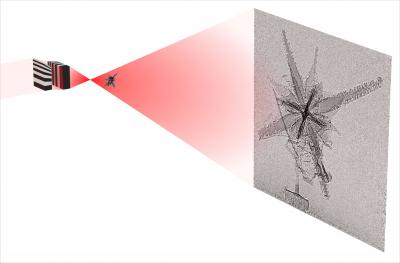Sharpening the X-ray view of the nanocosm

Two orthogonal lenses focus the X-ray beam into a small spot. The object under investigation (Acantharia, a marine plankton about 50 microns in diameter, with spikes showing nanostructured details) is placed close to the focus and a highly magnified holographic image is recorded with the detector. This measurement was made at P06 beamline, PETRA III, DESY, Germany. Credit: Saša Bajt, Mauro Prasciolu, Holger Fleckenstein, Martin Domaracky, Henry N. Chapman, Andrew J. Morgan, Oleksandr Yefanov, Marc Messerschmidt, Yang Du, Kevin T. Murray, Valerio Mariani, Manuela Kuhn, Steve Aplin, Kanupriya Pande, Pablo Villanueva-Perez, Karolina Stachnik, Joe P. J. Chen, Andrzej Andrejczuk, Alke Meents, Anja Burkhardt, David Pennicard, Xiaojing Huang, Hanfei Yan, Evgeny Nazaretski, Yong S. Chu and Christian E. Hamm; Light: Science & Applications; DOI: 10.1038/lsa.2017.162
A novel lens offers scientists the sharpest X-ray images yet from the nano world. The device is made from alternating layers of tungsten carbide and silicon carbide and can focus hard X-rays into a spot of less than ten nanometers in diameter as a team lead by Saša Bajt from the German research center Deutsches Elektronen-Synchrotron DESY report in Light: Science and Applications, a journal of the Nature Publishing Group.
The short wavelength and the penetrating nature of X-rays are ideal for the microscopic investigation?of complex materials. For example, nanometer resolution X-ray images provide better understanding of structure and function of materials, which is critical for the development of new materials with improved properties.
This requires bright X-ray sources but also highly efficient and almost perfect x-ray optics. To acquire images, the X-rays must be focused : as in a light microscope. This is not easy as high energy X-rays penetrate most materials unimpeded and cannot be significantly manipulated with conventional lenses.
The multilayer Laue lens overcomes this problem. This device is basically a synthetic nanostructure that diffracts X-rays much like a crystal. If shaped the right way, the incident X-rays can all be concentrated in a very small focus.
The synthetic nanostructures are prepared by magnetron sputtering. We introduced a new pair of materials, tungsten carbide and silicon carbide, to prepare layered structures with smooth and sharp interfaces and with no material phase transitions that hampered the manufacture of previous lenses. Equally important is the control of the layer thickness and shape with atom-scale precision, explains Bajt.
The sub-nanometer control of layer thickness gained through sputter deposition is considerably better than obtainable in a lithography process , a process used to prepare lithographic zone plates commonly used in x-ray microscopes operating at lower X-ray energies.
The high aspect ratio (smallest layer thickness vs. optical lens thickness) of the deposited layers makes for very efficient x-ray focusing, which is critical for fast imaging. The paper presents different characterization methods and ways to reduce remaining lens imperfections. The team is convinced that creating lenses approaching a single nanometer resolution is possible.
###
X-ray focusing with efficient high-NA multilayer Laue lenses; Saša Bajt, Mauro Prasciolu, Holger Fleckenstein, Martin Domaracky, Henry N. Chapman, Andrew J. Morgan, Oleksandr Yefanov, Marc Messerschmidt, Yang Du, Kevin T. Murray, Valerio Mariani, Manuela Kuhn, Steve Aplin, Kanupriya Pande, Pablo Villanueva-Perez, Karolina Stachnik, Joe P. J. Chen, Andrzej Andrejczuk, Alke Meents, Anja Burkhardt, David Pennicard, Xiaojing Huang, Hanfei Yan, Evgeny Nazaretski, Yong S. Chu and Christian E. Hamm; Light: Science & Applications; DOI: 10.1038/lsa.2017.162
Media Contact
All latest news from the category: Physics and Astronomy
This area deals with the fundamental laws and building blocks of nature and how they interact, the properties and the behavior of matter, and research into space and time and their structures.
innovations-report provides in-depth reports and articles on subjects such as astrophysics, laser technologies, nuclear, quantum, particle and solid-state physics, nanotechnologies, planetary research and findings (Mars, Venus) and developments related to the Hubble Telescope.
Newest articles

Properties of new materials for microchips
… can now be measured well. Reseachers of Delft University of Technology demonstrated measuring performance properties of ultrathin silicon membranes. Making ever smaller and more powerful chips requires new ultrathin…

Floating solar’s potential
… to support sustainable development by addressing climate, water, and energy goals holistically. A new study published this week in Nature Energy raises the potential for floating solar photovoltaics (FPV)…

Skyrmions move at record speeds
… a step towards the computing of the future. An international research team led by scientists from the CNRS1 has discovered that the magnetic nanobubbles2 known as skyrmions can be…





















